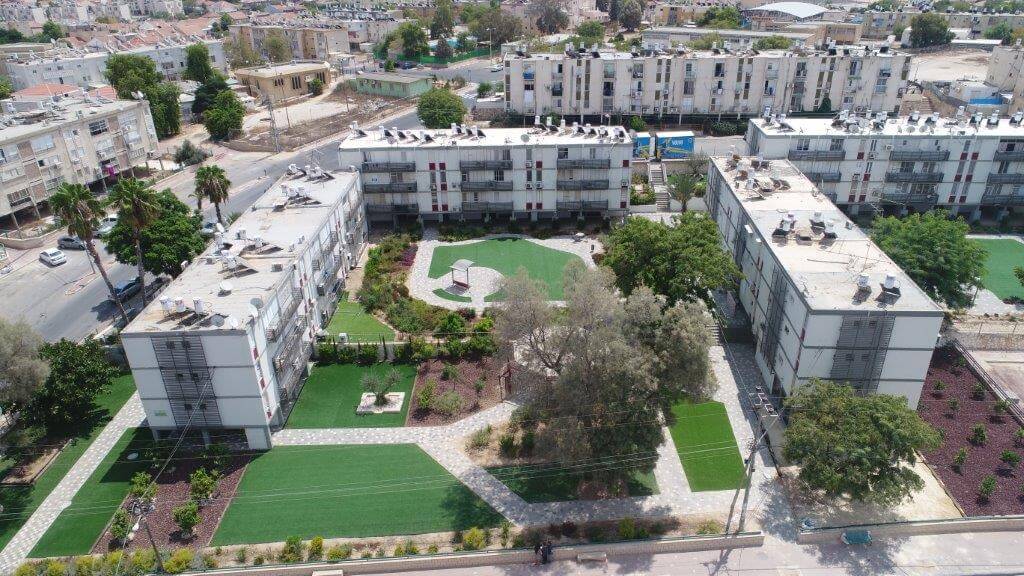"Good Neighborhood" project
Description
The "Good Neighborhood" project ("Shkhuna Tova") promotes the production of renewable energy and the construction of solar installations on building rooftops. At the same time the project improves the living standards and financial savings of disadvantaged populations in the geographic and social periphery of Israel and strengthening a sense of community. This project was a breakthrough in an area which had been a real challenge in Israel, which is utilizing the roofs of apartment buildings for solar energy installations.
Israel is a small densely populated country with over 90% of its inhabitants living in urban areas. In order to comply with its 2030 renewable energy target and increase the proportion or renewables in its energy mix, Israel must utilize every opportunity to harness its sunny climate for the production of solar energy.<br />
This project focuses on public housing and carries out renovations including energy saving insulation and the installation of photovoltaic solar energy system, together with thermos-solar rooftop heating systems as well as landscaping and the creation of green open space around the building.<br />
The installation of the systems and the renovation is financed by KKL and government funds. Funding comes from public sources and no participation of tenants is required for the cost of construction. During the operation period of the rooftop solar energy system (estimated for at least 20 years), the financing for maintenance and upkeep of all the aspects the project will come from the electricity generation of the PV solar system only. In other words, no additional budget will be required from the tenants. Revenues from the photovoltaic system are expected to cover all required operating expenses including maintenance costs, taxation fees, licensing and insurance). The remainder will be used to maintain other public housing services such as painting and gardening. The first step taken is the provision electricity for hallway and public areas lighting is covered increasing a sense of security for residents. <br />
The project benefits tenants this will enable payments of maintenance in view of the savings in shared electricity costs, the improvement of the property, improvement in quality of life in light of improvements in the built-up area - light in stairs, a well-tended garden and the care and maintenance of the building. It will also contribute to resilience and adaptation for extreme weather events due to the better insulation and the renewable energy based lighting and hot water. The project will contributes to strengthening the sense of community among the residences as well as improving the value of the property and the resident's economic conditions.<br />
The environmental advantages for government are in the increased production of renewable energy, reducing air pollution and promoting the benefit of decentralization of electricity production.<br />
The project corresponds with a number of goals and targets of the SDG. The project helps to reduce air pollution, promote renewable energy usage, and improve energy efficiency. It contributes to the advancement of disadvantaged populations in the periphery and reducing inequality, and creates more sustainable and inclusive communities and cities. Thus "Good Neighborhood" project creates interlinkages among several goals – no poverty, good health and well-being, affordable and clean energy, reduced inequalities, sustainable cities and communities and climate action.
The implementation of the project is done by the construction and maintenance companies - Amidar and Amigour, which are the major providers of subsidized and rent-controlled housing, primarily for the lower socio-economic sector of the population. There is also a small integration of the civil society organizations in the project, mainly in the encounter with the local population.
Another impact of the project is by changing the work specifications for the new construction projects of Amidar and Amigour, and for the ministry of Construction and Housing. The new buildings that will be built will already include solar systems on their roofs, thereby help to bypass one of the main barrier of the project.
In order to cope with this situation, various solutions were suggested. The first required legislative amendments so that it would no longer be necessary to obtain agreement of all the tenants in order to use the jointly owned rights to the roof of building. The amendment is being worked on so that only two-thirds of tenants would have to agree to that solar energy installation. Should this amendment come into effect, it is anticipated that many more solar installations will be put up. However amending legislation is not a quick or simple matter.
The second solution was to construct solar systems on completely state-owned buildings (such as seniors housing) located near the public housing which is to benefit from the income from energy production. In this case, the profits from the production of energy will still be directed to the public houses tenants, and will be used for the maintenance of the buildings, thus bypassing the barrier of full residents agreement.
SDGS & Targets
Deliverables & Timeline
Resources mobilized
Partnership Progress
| Name | Description |
|---|
Feedback
Action Network


Timeline
Entity
Region
- Europe
Photos

Website/More information
Countries

Contact Information
Ziv Rotshtein, Mr.
